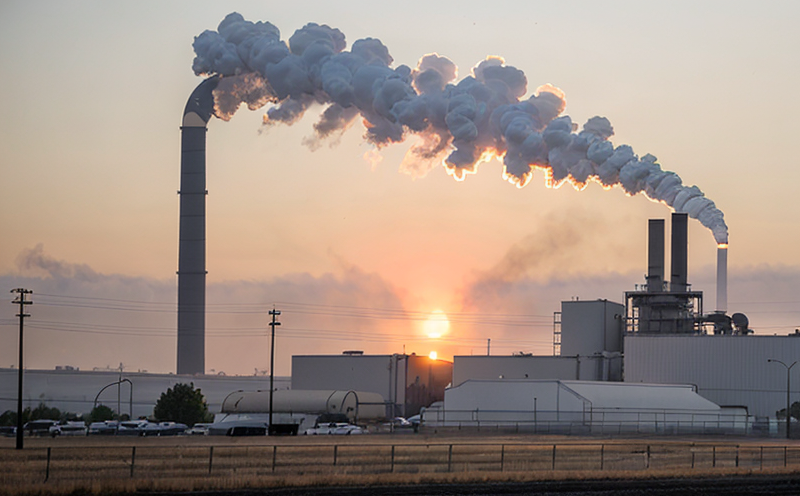ISO 16017 VOC Sampling and Testing in Factories
The Industrial Air Quality & Emission Testing service, specifically focusing on the implementation of ISO 16017 for Volatile Organic Compounds (VOC) sampling and testing within factories, is a crucial component of environmental monitoring. This standard provides comprehensive guidelines for the accurate measurement of volatile organic compounds in ambient air, ensuring compliance with international emission limits.
The process involves several critical steps: sample collection using appropriate sampling devices such as sorbent tubes or canisters, transportation to the laboratory, and subsequent analysis by gas chromatography-mass spectrometry (GC-MS) or other suitable analytical methods. The accuracy of these measurements is paramount for effective environmental management.
Sampling must be conducted in a manner that minimizes bias and ensures representativeness. This often involves selecting appropriate sampling locations within the factory premises, considering factors like emission sources, air flow patterns, and prevailing wind directions. Sampling intervals can vary based on specific regulatory requirements or internal policies aimed at maintaining consistent environmental quality.
Once collected, samples undergo rigorous preparation processes in our state-of-the-art laboratories. This includes desorption of VOCs from sorbent tubes if applicable, dilution to achieve optimal analysis concentrations, and introduction into the GC-MS for identification and quantification. Our laboratory adheres strictly to ISO 16017 standards throughout these procedures.
The results generated are detailed reports providing comprehensive data on identified compounds along with their respective concentrations. These reports serve multiple purposes including regulatory compliance verification, process optimization efforts by R&D teams, and strategic decision-making for quality managers overseeing factory operations. Compliance officers rely heavily upon such data to ensure adherence to local environmental regulations.
For instance, industries like petrochemicals, paint manufacturing, and electronics production frequently utilize this service due to their high emission rates of volatile organic compounds. By leveraging ISO 16017 compliant VOC sampling & testing services, these organizations can better manage emissions while also identifying potential areas for improvement in terms of operational efficiency.
The importance of accurate VOC measurement cannot be overstated given the adverse health impacts associated with prolonged exposure to certain VOCs as per WHO guidelines. Thus, implementing best practices outlined by ISO 16017 ensures not only legal compliance but also contributes positively towards public health and environmental sustainability goals.
| Sampling Device | Description |
|---|---|
| Sorbent Tube | A tube filled with sorbents designed to trap VOCs from the air stream. |
| Canister | An airtight container used for holding gas samples over extended periods. |
| Analysis Method | Description |
|---|---|
| Gas Chromatography-Mass Spectrometry (GC-MS) | An analytical technique that separates and identifies components of complex mixtures. |
| Fourier Transform Infrared Spectroscopy (FTIR) | A spectroscopic method used for the identification of organic compounds based on their interaction with infrared radiation. |
Why It Matters
The implementation of ISO 16017 VOC Sampling and Testing in Factories is essential for several reasons. Firstly, it helps organizations meet stringent environmental regulations set by governmental bodies worldwide. Non-compliance can lead to hefty fines and reputational damage, making adherence critical.
- Regulatory Compliance: Ensures factories operate within legal limits prescribed by international standards.
- Emission Reduction: Identifies high-emission areas enabling targeted interventions for reducing pollutants.
- Health & Safety: Protects workers and surrounding communities from harmful VOC emissions.
In addition, this service supports sustainable business practices by offering valuable insights into production processes. It allows companies to pinpoint inefficiencies or unintended waste streams that could be addressed through improved technologies or better work practices.
Moreover, the data provided can inform strategic decisions related to facility design and expansion projects ensuring they meet stringent air quality standards from day one. This proactive approach not only minimizes risks but also enhances a company’s reputation as an environmentally responsible entity.
Benefits
- Informed Decision Making: Provides accurate and reliable data to guide operational decisions towards reducing emissions.
- Compliance Assurance: Ensures adherence to local, national, and international emission regulations.
- Risk Mitigation: Identifies potential risks early on preventing costly penalties or reputational damage.
- Sustainable Operations: Encourages sustainable practices leading to long-term cost savings and enhanced efficiency.
Use Cases and Application Examples
- Petrochemical Plants: Monitoring emissions from chemical reactions that generate significant amounts of VOCs.
- Paint Manufacturers: Assessing the off-gassing levels during painting processes to ensure product quality.
- Electronic Factories: Evaluating the release of solvents used in circuit board manufacturing.
| Industry | Potential Emissions |
|---|---|
| Petrochemical Plants | Vinyl chloride, benzene |
| Paint Manufacturers | Toluene, xylene |
| Electronic Factories | Ethanol, acetone |





